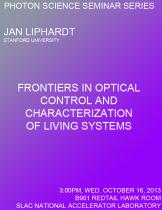Jan Liphardt (Stanford University)
In the last decade, there have been a series of unexpected advances in light microscopy. Most importantly, there are now several approaches for circumventing the diffraction limit of the light microscope. These "super-resolution" optical methods are now being applied to relatively thick, living samples such as entire C. elegans embryos. In addition, biologists are now beginning to control a variety of processes with light, allowing a single instrument to be used to accurately manipulate and characterize living systems on spatial scales of 10 nm to millimeters. Despite the advances in light microscopy, there are numerous key problems in biology which require significantly higher spatial and temporal resolutions or where the molecules of interest cannot be readily labeled. In the future, it will be essential to combine the new optical technologies with complementary approaches using x-rays, helium ions, or electrons. I'll give an overview of the super-resolution light microscopy world and discuss several examples of biological or medical problems where integrated approaches would be valuable.





